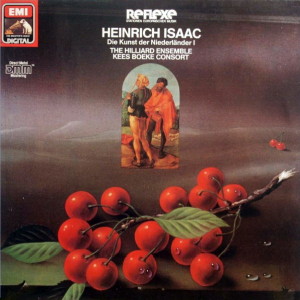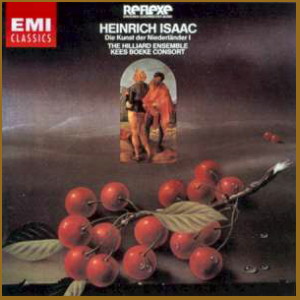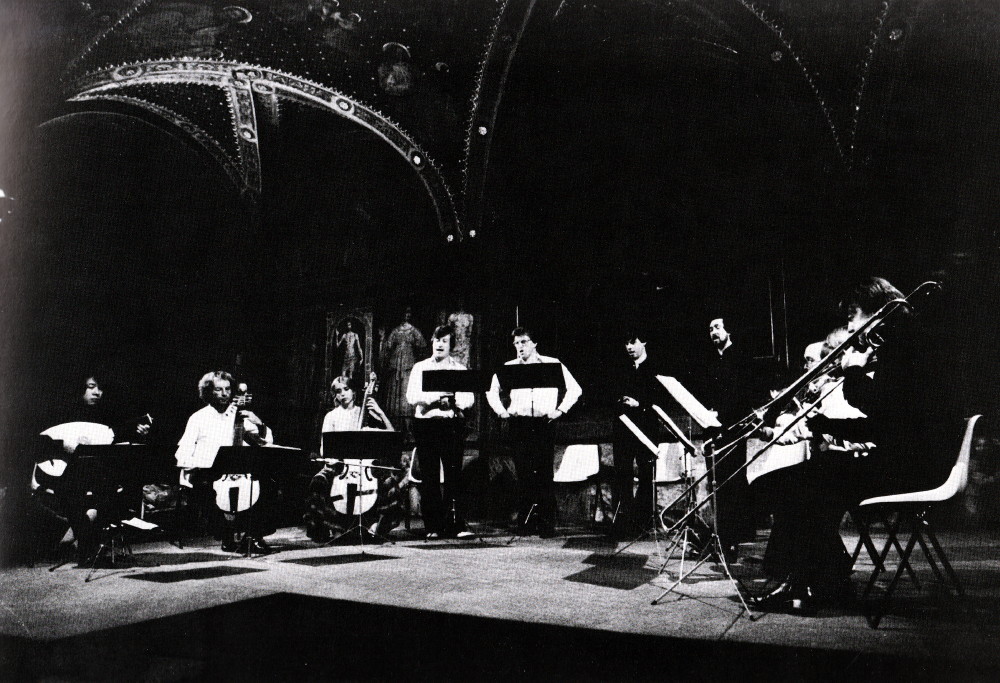 |
1 LP -
1C 069-1466921 - (p) 1983
|

|
| 1 CD - 8
26530 2 - (c) 2000 |
 |
| 1 CD -
CDM 7 63063 2 - (c) 1989 |
|
| HEINRICH
ISAAC (ca. 1450-1517) - Die Kunst der
Niederländer I |
|
|
|
|
|
| Commune Festorum
Beatae Maria Virginis -
Motette zu sechs Stimmen: Introitus:
Salve, Sancta Parens - (1, 5, 6,
2, 3, 4 & 10) |
4' 26" |
|
| Missa Paschale
zu sechs Stimmen - (5, 1, 2, 6,
4, 10) |
21' 14" |
|
| - Kyrie |
7' 47" |
|
| - Gloria |
6' 45" |
|
| -
Sanctus |
4' 24" |
|
| -
Agnus dei |
2' 16" |
|
|
|
|
| Quis dabit pacem
populo timenti - Motette zu
vier Stimmen - (1 & 4 &
9) |
4' 38" |
|
| Es het ein Baur
ein Töchterlein - Lied zu vier
Stimmen - (1, 2, 3, 4) |
1' 48" |
|
| Es
wolt ein meydlein grasen gan -
Lied zu vier Stimmen - (1, 2, 3,
4) |
1' 05" |
|
| Greiner, zancker,
schnöpffitzer - Lied zu vier
Stimmen - (1-4, 5, 6, 10) |
1' 07" |
|
| J'ay
pris amours - Chanson zu 3
Stimmen - (1, 9, 7) |
3' 07" |
|
| Fammi
una gratia, amore - Madrigal
zu drei Stimmen - (1, 2, 4) |
3' 30" |
|
| La
Mora - Intavolierung für Laute
von Hans Newsidler (1508?-1563) aus
"Ein newgeordnet künstlich
Lautenbuch, 1536" |
3' 17" |
|
| Ne
più bella di queste - Madrigal
zu vier Stimmen - (I.: 1-4; II.:
1-4, 7, 9; III.: 1-4, 5, 6; IV.:
1-10) |
3' 58" |
|
|
|
|
| THE HILLIARD
ENSEMBLE |
KEES
BOEKE CONSORT |
|
| 1.
David James, Kontratenor |
5.
Bruce Dickey, Zink (Philippe
Matharel, Toulouse, 1978) |
|
| 2.
Paul Elliott, Tenor |
6.
Charles Toet, Tenorposaune
(Meinl & Lauber, nach
Sebastian Hainlein, Nürnberg, 1627)
|
|
| 3.
Leigh Nixon, Tenor |
7.
Titia de Zwart, Gambe (David
Rubio, London, 1973)
|
|
| 4.
Paul Hillier, Baß |
8.
Kees Boeke, Gambe (David Rubio,
London, 1973)
|
|
|
9. Toyohiko Satoh, Renaissance-Laute
(Kazuo Sato, 1980, nach Giovanni
Hieber, 16. Jh.) |
|
|
10. Richard Lister, Baßposaune
(Meinl & Lauber, 1971 nach
Sebastian Hainlein, Nürnberg, 1622)
|
|
|
|
|
|
Luogo
e data di registrazione |
|
Doopsgezinde
Gemeente Kerk, Amsterdam (Olanda)
- 12-18 dicembre 1981 |
|
|
Registrazione: live /
studio |
|
studio |
|
|
Producer / Engineer |
|
Gerd
Berg / Hartwig Paulsen |
|
|
Prima Edizione LP |
|
EMI
Electrola "Reflexe" - 1C
069-1466921 - (1 lp) - durata 48'
59" - (p) 1983 - DMM (Digitale) |
|
|
Prima Edizione CD |
|
EMI
"Classics" - CDM 7 63063 2 - (1
cd) - durata 48' 59" - (c) 1989 -
DDD |
|
|
Edizione CD |
|
EMI
"Classics" - 8 26530 2 - (1 cd) -
durata 48' 58" - (c) 2000 - DDD |
|
|
Note |
|
Aufgenommen
in Zusammenarbeit mit WDR. |
|
|
|
|
|
 HEINRICH ISAAC HEINRICH ISAAC
Heinrich Isaac was born in the
mid-15th century, in all
probability in Flanders. We
have no reliable information
on the first 35 years of his
life, and the first document
containing his name tells us
that he stayed in Innsbruck,
evidently on his way to
Florence. He arrived there in
1484 or 1485, and offered his
services at the court of
Lorenzo de’ Medici (il
Magnifico) - initially
as a singer in the Cappella di
San Giovanni, thereafter in
the churches of Santa Maria
del Fiore and Santissima
Annunziata as well. The
possibility of his having
studied with the famous
organist Squarcialupi and
equally that of Isaac’s having
taken over Squarcialupi's
post as organist after his
death are all but ruled out by
present-day
scholarship. Isaac worked
chiefly as maestro di
cappella and court
composer. The degree of trust
that the Medici family’s most
famous offspring placed in
Isaac is shown by the fact
that he was entrusted
personally with the musical
education of Lorenzo’s
children, among whom Giovanni,
later to be crowned Pope Leo
X., was a particularly good
student - a number of his
compositions survive.
When Lorenzo died in 1492,
Isaac remained in the employ
of the Medicis; the overthrow
of the family, however,
instigated by the fanatical
monk Savonarola, forced him to
seek another patron. It is
well known that Savonarola had
a colossal quantity of musical
instruments and secular
compositions consigned to the
bonfire in his frenzied fight
against the increasing
secularization of the church.
(The Canti Carnascialeschi
are one example of the
compositions lost in this
way.) As a result, we can
establish only with difficulty
what rôle
the various types of
instrument played in the
musical life of Florence, and
what the relationship was
between the sacred and the
profane “repertoires”.
Chance would have it that the
Habsburg Emperor Maximilian I,
whom birth, tradition and his
marriage to Maria of Burgundy
almost inevitably made one of
the greatest patrons of the
arts that Europe has ever
known, was staying near
Florence at the time. To be
more precise, the Emperor was
in Pisa, where he was trying
to bring Italy under the rule
of the Spanish-Habsburg
empire. He took Isaac into his
service as court composer,
initially for a trial period,
and sent him on to Vienna,
where he was to await further
instructions. From this point
onwards, Isaac repeatedly
appeared for shorter or longer
periods in the cultural
centres of Italy and Germany.
His contract of employment
with Maximilian - he was
composer to the court, not Kapellmeister
- gave him the freedom to
travel a good deal, and time
after time he returned to
Florence, the city in which he
felt most at home and the
birthplace of his wife
Bartolomea Belli. He also made
prolonged visits at intervals
to Augsburg (1500), Constance
(1507/8) and Verona (1510).
After 1512 he was more or less
permanently settled in
Florence, and, as a result of
friends' intervention, Pope
Leo X. provided him with a
“pension” at the level of his
last salary under the Medici
as thanks for service
rendered.
Commune Festorum Beatae
Mariæ
Virginis
The introitus
composition at the beginning
of the programme belongs to
the genre of chorale and psalm
arrangements; in this kind of
composition the treatment of
the original chorale melody is
left entirely to the
composer`s imagination. Isaac
decided on a highly compact
six-part setting. The piece
was composed around 1500 and
must be counted among Isaac`s
late works.
Missa Paschale
Isaac's compositions for the
Mass have only recently been
subjected to precise
examination and evaluation. In
terms of both quality and
quantity, they should perhaps
be assigned pride of place in
his œuvre
and indeed among the works of
his immediate contemporaries.
Altogether there are some
fifty compositions of the
most varied
kinds - four Easter masses
(for three, four, five and six
voices) alone came from
Isaac’s pen. The Missa
Paschale is one of the
so-called “alternatim” masses,
in which not all the sections
of the Mass are set
polyphonically, some parts
consisting solely of the
original Gregorian melody.
This genre was cultivated for
the most part in Germany,
which would suggest that Isaac
wrote the work while resident
in a German-speaking country.
In accordance with the then
current practice, the
non-polyphonic sections were
either filled out with organ
improvisations on the
prescribed melody, or they
were sung in unison (as
Gregorian chorale). The
technique used by Isaac in the
parts set polyphonically was
known by the name contrapunctus
fractus seu floridus,
once again a composition
technique native to
German-speaking countries,
which was also called Spaltsatz
(literally, “split phrasing”),
A basic feature of this
practice is a great difference
in the note values of the
chorale melody (long notes)
and of the accompanying parts,
which possess far greater
flexibility. This mass was
presumably also written in
Germany, which points to a
dating of 1496/97.
Carmina
The Carmina (songs)
occupy an important place in
Isaac’s work, not least
because they include a group
of purely instrumental
compositions which must be
considered the earliest, and
certainly the best of their
genre. On the other hand, this
may be the reason why, until
recently - and even today this
remains the case - the value
of Isaac’s religious music has
not been adequately
recognised. The Carmina -
Isaac composed Latin, French,
German and instrumental pieces
- bear striking witness to the
master’s quite incredible
versatility and flexibility:
German folk songs, French rondeuux,
Italian frottole, all
perfect in their idiom and at
the same time unmistakably
Isaac.
At the death of Lorenzo il
Magnifico in 1492, Isaac
composed two works in his
memory, and both begin, oddly
enough, with the words Quis
dabit. The less
wellknown of the two, Quis
dabit pacem populo timenti,
was written to a text from the
pen of the Humanist Angelo
Poliziano, also resident at
the Medici court, who in turn
used Hercules Oetaeus
as his source.
Most of the instrumental
Carmina are based on folk
songs composed one or more
generations earlier, a highly
popular technique that is also
used for the most part in the
so-called “Parody Mass”. Es
het and Es wolt
are both, in more or less the
same way, clearly ambiguous,
which is perhaps expressed
musically in the contrasting
of extreme polyphony (with the
melody in every part) and the
emphatically homophonic
chordal blocks. One especially
risqué feature:
the phrase “Fick mich" in Es
wolt, which leaves
nothing to chance (it means
“fuck me”!),
was replaced in later editions
by the more imaginative “Juck
mich” (= “scratch me”) - plus
ça
change... Greiner,
Zancker belongs likewise
in its country of origin to
this genre of racy songs. This
song which was almost
certainly born as a street
ballad, also exists in a nice
setting by Isaac’s
contemporary Paul Hofhaimer,
who was also employed by
Maximilian.
The group of French Carmina
begins with a setting of J’ay
pris amours a rondeau
of unknown provenance. The
three-part setting combines a
new treble (sung) with two
accompanying instrumental
parts.
The two Italian Carmina
require a more detailed
commentary. Lorenzo de’ Medici
was a great patron of open air
festivities and similar events
in Florence, and the so-called
Canti Carnascialeschi
or carnival songs were
indispensable at these
performances. Textually, they
were related to the old caccie
(canons sung to “raw” texts);
musically speaking, they
tended to be influenced by the
vertical composition style of
the frottola. Owing to
Savonarola’s fanaticism (vide
supra), which had such grave
consequences for music
history, not many examples of
this genre (to which Alexander
Agricola was one of the
contributors) have survived. Ne
più
bella di queste is
probably a very personal
panegyric to the city of
Florence, which held such
fascination for Isaac.
Kees
Boeke
Translation:
Clive Williams
|
|
|
EMI Electrola
"Reflexe"
|
|
|
|

